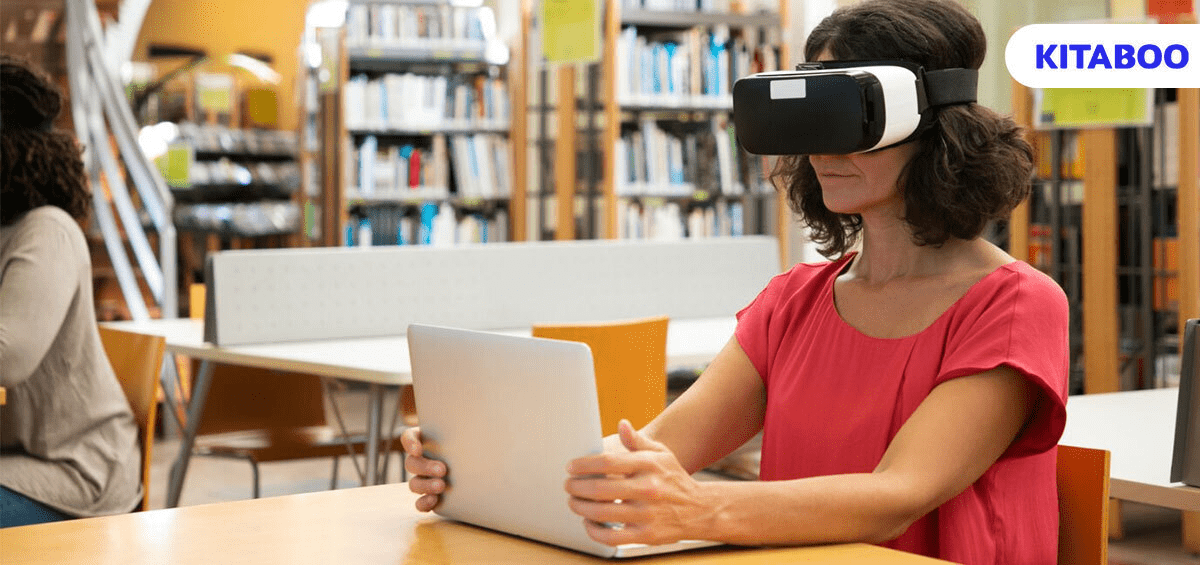In the last decade, technologies like virtual reality (VR), augmented reality (AR), and artificial intelligence (AI) have redefined the education system. AR is an emerging tool in various disciplines like medicine, entertainment, and the military, along with education.
Augmented reality books have facilitated active participation in learners as opposed to the conventional teaching-listening method. It has also created a niche by allowing mixed reality to prevail, where a physical and virtual environment are merged.
While using augmented reality books, a person can continue accessing paper-based textbooks with an add-on of a virtual environment for an immersive experience. Digital textbook platforms like KITABOO have been facilitating the creation, editing, and distribution of cutting-edge digital textbooks that use technology to enhance learning across the globe.
Table of Contents
I. What are Augmented Reality Books?
II. How Does Augmented Reality Work in Books for Learning?
III. The Impact of Augmented Reality Books For Educational Use
- Mental Stimulation
- Simplified Complex Concepts
- Multimodal, Multi-Sensory Learning
- Improved Skill Building
- Future-Preparedness
What are Augmented Reality Books?
Augmented reality books are a new-age concept that offers mixed reality by combining the traditional learning experience through books with interactive elements that make the course content come to life.
AR overlays virtual content over physical books. Learners can use an AR app or a device to scan the pages of a physical textbook to have a more engaging 3D experience.
There is also an option to use AR headsets for a more advanced experience; however, that is not a must. Augmented reality books enhance visualization and gamification in education, providing many benefits that improve student learning outcomes.
Apart from educational books, AR can also do wonders for children’s books, atlases, travel guides, etc.
How Does Augmented Reality Work in Books for Learning?
Understanding the technological components of augmented reality books will shed light on how they work. A research that discussed AR books offered interesting insights.
- The display for AR books could be a head-mounted display (HMD) or a non-head-mounted display (Non-HMD).
- They can either use a marker-based or a non-marker-based technology for tracking (to overlay virtual elements). Marker-based technology is a standard where the AR device recognizes the markers on the books to offer multimedia aspects. A non-marker-based technology that is more immersive is being studied.
Augmented reality books contain a Graphical User Interface (GUI) utilizing a mouse, keyboard, and screen and a Tangible User Interface (TUI) incorporating physical objects like paddles embedded with markers, cubes, and real-life objects.
The Impact of Augmented Reality Books For Educational Use
Augmented reality books offer many benefits that could bring about a paradigm shift in education.
Apart from improving retention, providing global accessibility, promoting inclusion, and facilitating different highly engaging learning methodologies like personalized learning, some of the ways they have impacted education are:
1. Mental Stimulation and Increased Engagement
2. Simplified Complex Concepts
Through the use of visual aids that can be viewed in 3D, AR books simplify concepts.
Information that may seem abstract on paper can come alive through visualization and illustration, making it more digestible. AR can also improve a learner’s visualization skills, according to a study.
3. Multimodal, Multi-Sensory Learning
Augmented reality books offer more than one mode of learning. Students can use visual, auditory, kinesthetic, etc., ways to learn apart from reading and writing.
They also engage multiple senses and may soon offer tactile interaction. A recent study found that AR in education can improve the quality of student learning.
4. Improved Skill Building
An analysis of AR books in educational use conducted by a study found that AR books can improve foreign language learning by increasing motivation and academic achievement. When it comes to career courses, AR books can increase immersion.
For a variety of subjects, they enhance understanding of principles. All of this results in improved and faster skill building for learners, who start finding learning to be fun.
Also Read: Protect eBooks from Piracy
5. Future-Preparedness
Books powered by augmented reality prepare students to embrace the future that will contain these technologies. Future workplaces may require understanding and applying AR-backed tools, and augmented reality books can prepare them for that.
A Three-Step Process to Create Augmented Reality Books
If augmented reality books interest you, you can start with this three-step process to develop one.
Step 1: Define Your AR Content
Which elements of your books can be adapted for augmented reality? How will the learning experience benefit by adding sounds, visual effects, and other 3D elements?
Begin by answering these two questions and choose what parts of a book are ideal for an AR experience without compromising on the integrity of the text.
Step 2: Plan from A to Z
Begin by deciding whether to create a paper book or an eBook. Next, plan how many phases you want to create augmented reality books in.
Create a budget, seek approvals, and build a team to oversee the process. Make sure you have deadlines and objectives communicated clearly to all stakeholders.
Step 3: Choose the "How"
Once you have a plan in place, depending upon the complexity of the AR elements, you can choose your tools. Do you need a custom AR app? Or will off-the-shelf SDKs (software development kits) work? Would you need 3D catalogs for your AR book?
If all of this seems overwhelming, consulting experts and bringing them on board as partners is always advisable. Once you have planned the implementation, work on creating a training program to maximize the benefits of AR in books.
Closing Thoughts
Augmented reality books focus on “doing” more than “listening,” resulting in higher student success outcomes. Despite the technology not being new, it’s still gaining momentum in the education space, with practical applications being tested on books.
Augmented reality books can change everything from instructional design to personalized learning, opening up new horizons in eLearning through innovation.
If you want to experience what digital textbooks can do for your organization, contact us at KITABOO. We offer end-to-end, completely customizable creation and distribution of AI-powered digital textbooks. Our platform, which anyone can use, is built by experts and can help you create interactive and innovative textbooks for pedagogy.
To know more, write to us at KITABOO@hurix.com.
Suggested Reads:
- How Digital Transformations Are Making K12 Education More Equitable
- Adaptive Leadership
- Edit EPUB Files Online
- Convert PDF to Reflowable ePub
- Importance of eBooks in Online Education
Discover How An Ebook Conversion, Publishing & Distribution Platform Can Help You
Kitaboo is a cloud-based content platform to create-publish & securely distribute interactive mobile-ready ebooks.
You May Also Like
-
Customizable eBook Reader App for Your Brand
Blog,Digital Publishing,eBook solution / March 22, 2024








